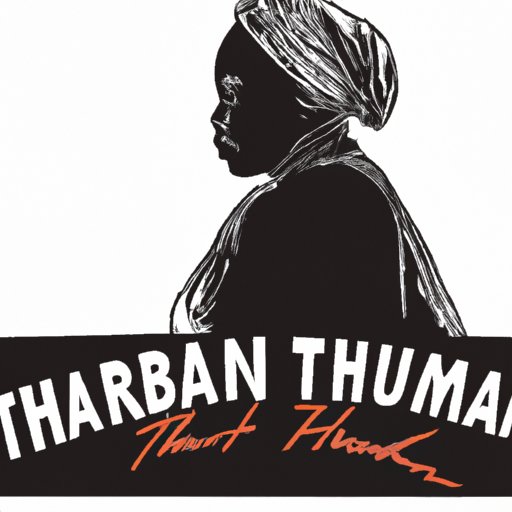Introduction
For many people, the name Harriet Tubman is synonymous with freedom. Tubman, a former slave turned abolitionist, worked tirelessly to free enslaved individuals through the Underground Railroad. However, while most of us know the many stories of Tubman’s bravery and success, the exact number of people she helped to free remains a mystery. In this article, we will explore the legacy of Harriet Tubman and attempt to uncover the true number of people she liberated during her time as a conductor on the Underground Railroad.
Beyond the Underground Railroad: Uncovering the True Number of People Harriet Tubman Freed
Historians have long debated how many people Harriet Tubman helped free during her time on the Underground Railroad. Some estimates have put the number as low as seventy, while others have suggested that Tubman may have helped free more than 300 people over the course of her lifetime. These varying estimates are due in part to the clandestine nature of the Underground Railroad and the fact that Tubman was hesitant to share details about her work.
Another challenge in tracking the number of people Tubman liberated is the fact that many of her missions were done in secret and without formal records. In some cases, Tubman would lead groups of escapees to freedom and then disappear back into the shadows, only to resurface later to continue her work. This secretive approach made it difficult to account for every person she helped to free.
Following Harriet Tubman’s Footsteps: A Look at Her Journey to Free Slaves
To truly understand the impact of Harriet Tubman’s work, it is important to explore her journey on the Underground Railroad and the specific people she helped to free. Tubman was born into slavery in Maryland in the early 1820s and was forced to work as a domestic servant from a young age. In her early twenties, she escaped slavery and made her way north to Philadelphia, where she eventually became involved in the abolitionist movement and began working as a conductor on the Underground Railroad.
Despite the many dangers and challenges she faced, Tubman made numerous trips back to the South to help enslaved individuals escape to freedom. She became known for her cunning and resourcefulness, often using disguises and secret codes to evade capture and help others do the same. Some of the people she helped free included her own family members, as well as complete strangers who were seeking a better life.
The Legacy of Harriet Tubman: Examining Her Success in Freeing Enslaved Individuals
The impact of Harriet Tubman’s work can be seen in the many lives she changed through her efforts to help enslaved individuals escape bondage. Not only did she help free hundreds of people during her time on the Underground Railroad, but she also served as a powerful symbol of Black resistance and resilience. Tubman’s work inspired generations of activists and abolitionists who fought for civil rights and worked to end slavery.
In addition to her work on the Underground Railroad, Tubman was also active in the suffrage movement and worked to secure voting rights for women. Her legacy continues to be celebrated today, with many schools, parks, and community centers named in her honor. In 2016, it was announced that Tubman would be the new face of the $20 bill, replacing former president Andrew Jackson.
Counting the Lives Harriet Tubman Changed: A Study on the Number of People She Liberated
In recent years, there has been renewed interest in uncovering the full scope of Harriet Tubman’s impact. Scholars and researchers have been studying her life and legacy in depth, attempting to piece together a more comprehensive picture of the people she helped free during her time on the Underground Railroad.
One study conducted by historian Kate Clifford Larson found evidence to suggest that Tubman may have helped as many as 300 people escape slavery over the course of her lifetime. Larson’s research involved combing through a variety of sources, including census records, court documents, and newspaper accounts. While her estimates cannot be confirmed with absolute certainty due to the clandestine nature of Tubman’s work, they do provide a more nuanced understanding of the scope of her impact.
Harriet Tubman’s Trail to Freedom: Tracing the Stories of Those She Helped Escape Slavery
One of the most powerful ways to understand the impact of Harriet Tubman’s work is by examining the stories of the individuals she helped to free. Among those who owe their freedom to Tubman were families torn apart by slavery, mothers desperate to provide a better life for their children, and individuals seeking refuge from the physical and emotional brutality of the slave system.
For example, one story that has been passed down through the years is that of a family of eight that Tubman helped to free from slavery in Maryland. The family, consisting of two parents and six children, were facing separation and violence at the hands of their slave owner. Tubman arrived under the cover of night and led the family on a treacherous journey through rivers, forests, and swamps before safely delivering them to freedom in the North.
Conclusion
While the exact number of people Harriet Tubman helped to free may never be known for certain, her legacy as a freedom fighter and a champion of human rights is indisputable. Her work on the Underground Railroad changed countless lives and continues to inspire and challenge us to this day. By studying her life and the people she helped free, we can gain a deeper understanding of the complex and often harrowing history of slavery, as well as the resilience and determination of those who fought for freedom and justice.
